This is the 4th post in a series about fire doors and the results of a recent (unscientific) survey.
The survey results included some pretty good answers as to what the rules for fire doors might be. Quite a few people knew that fire doors should be kept closed, but there’s an important clarification I want to make. Some respondents thought fire doors should be kept closed and never used unless there was an emergency. I think fire doors are getting confused with emergency exit doors here. Fire doors are not typically reserved for emergency use, they are doors that you use every day. With that said, let’s get started on the rules…
Rule #1 – A fire door must be SELF-CLOSING.
I read somewhere recently that the biggest problem with fire doors is that people prop them open or deactivate the door closer. I have no source for this information so consider it hearsay, but I can tell you that I see this ALL the time. A fire door will hinder the spread of smoke and fire only if it’s closed when the fire occurs. Therefore, fire doors must have reliable mechanisms for closing them – preferably door closers.
A door that closes each time it is opened may be inconvenient for some building occupants, so these doors are often propped open. Fortunately, there are many safe and code-compliant ways to hold a fire door open with devices that release and allow the door to close upon fire alarm or smoke detection. It will be more expensive to install one of these products instead of using a wood wedge, but we’re talking about peoples’ lives here.
I saw a newspaper article the other day about the Rosepark Care Home in Uddington, Scotland. The article reported details of an inquiry into a 2004 fire at the nursing home, and one of the major findings was that some of the door closers on residents’ room doors had been disabled. The open doors allowed the smoke and flames to spread rapidly, resulting in the deaths of 14 elderly patients. Here’s a short excerpt from that article, which appeared in The Herald – Scotland on January 26, 2010:
“Mr McNeilly said: ‘If a fire develops in one of those rooms that goes undetected, it could easily leave the room and go into the common escape area, which in turn puts all the other rooms at risk in that corridor. So the most important thing in that area is to keep the doors closed.’
Failing to do so could allow smoke and flames to ‘overwhelm’ the corridor, he said, jeopardizing an escape route which the other residents in that area of the home would rely on.
But last week, the inquiry heard that safety closure arms had been removed or disconnected from at least nine residents’ bedroom doors on the ground and lower floors.
Joseph Clark, Rosepark’s former general maintenance manager, said he had done so at the request of relatives, who complained that the heavy fire doors limited the ‘independence’ of some elderly and disabled residents, who would struggle to open them on their own.”
This story clearly illustrates how a fire door assembly inspection could have saved lives, but lives can be saved even without an official inspection. If you see a fire door that’s held open with a wood wedge, kick down stop, or a more creative means like the ones shown below, bring it to someone’s attention (and send me a photo!)! Your actions could make the difference!
Thank you to Matt Bouchard of Ingersoll Rand Security Technologies, and Eyal Bedrik of Entry Systems for some of these photos.
<– Read the previous post about the survey results.
You need to login or register to bookmark/favorite this content.


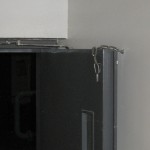
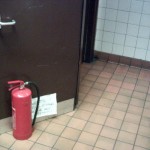
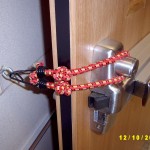
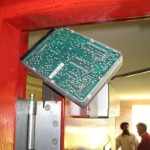
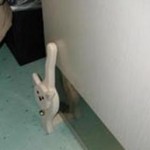
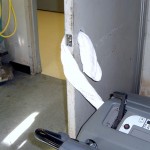




It is interesting topic for todays group. The fire door inspection program is an amazing way for some to see the difference the fire door has to a building. It is true even in Canada that fire doors are not looked at properly even though it is part of the fire code as there are not many who are able to inspect fire door but most have an idea of what a fire door should do. I have been called on a few times by major contractors to solve a few problems with fire door or just doors. It is interesting how (even in todays high end buildings) the set up or even how a fire door is to work with fire code. DHI has a great program for fire door inspection FDI and in British Columbia there is lots to do in that department. I have seen lots of public building with frames tagged but not the doors? or fire doors on backwards. There is a good reason for the fire code has the inspections of the fire doors as you have said it not uncommon to see things wrong on fire doors. It is in the fire code that fire doors are to be inspected and even if it is inspected once it would help. Fire doors are to be inspected once a year but most buildings are not looking at it and I believe it cost is the biggest issue as most doors don’t meet code. Please keep up the good work here
Hi. I’m looking for some advice please. I have just moved onto a new boarding school site and I am concerned that non of the doors are fire rated. They have no labeling on the hinge edge or elsewhere, and to me seem like cheap, hollow internal doors. I realise that’s not much to go on, but is there anything else that I could or should be looking for?
Hi John –
If the dorm is an older building, fire doors may not have been required at that time (also – if you’re in the UK I’m not familiar with the code requirements there). Is this the door between the bedroom and corridor? The label would be on the edge of the door and usually also in the frame rabbet. You could ask the facilities’ staff about it.
– Lori
What if closed fire doors mean residents die of summer heat because they can not ventilate their building in the cool of the evening or early morning?
What if closed fire doors cause a problem for the elderly who can not carry things like laundry or groceries and open the door at the same time?
Really from my point of view, with today’s fire alarms, and all the steps that have been taken to prevent fires, the problems caused by keeping doors closed at all times are not warranted.
If there must be laws to have fire doors, how about thinking of people with disabilities or suffering summer heat, and require all fire doors have away to be safely held open, and that automatically close when needed. There are good reasons for wedging the doors open.
Hi Carol –
There are ways to hold open fire doors in a code-compliant way, and doors can also be equipped with automatic operators. It’s possible to balance safety with requirements for ventilation and accessibility.
– Lori
Please, give me more information! I don’t know where to get an automatic release.
The door I want left open is a wood door in a wood frame and for years it was left open, until a new fire chief said it was a fire door. It is a door in the hall going to the laundry room and a gathering room. It has windows and therefore is ventilation that we really need in the heat, and keeping the door closed in winter makes the gathering room is too cold to use.
The fire doors at the ends of the hall going to the stairwell make sense and are metal fire doors in metal frames. Unfortunately, our best ventilation comes through that door. A magnetic release would be great but expensive. Because I now have a better understanding of that being a protected exit down the stairwell, I can grit my teeth and bare to leave it closed, but with our new fire alarm system, that seems unnecessary. The alarm would go off before a fire is a danger and it would be easy to close the door as we run out.
Hi Carol –
You might want to look at the Glynn Johnson Sensaguard…while it’s not inexpensive, it is battery-operated so you don’t have to run wires to it.
– Lori
Wow, that would make it more affordable. Thank you so much for this information!
My grandmother is 87 and uses a 4 wheel push Walker. I am trying to figure out how to find any kind of device to help her get in and out of her room. I am sure that her facility room door meets code regarding weight and pressure and auto close for fire safety …. But what kind of device can help her? She currently tries to reach forward across her chair seat to unlock and push the door open.
Hi Kimberly –
Perhaps an automatic operator (which automatically opens the door) and/or an electrified lock (which unlocks the door using a proximity card or other credential) would help your grandmother.
– Lori
Hi Lori,
What about fire rated shaft door. Do we still need door closer? This door will be use only when they need to do maintenance. So naturally, the door will always be closed. Another issue, if the door has the door closer, people could not work freely due to the space inside the shaft. Any specific code on this topic? Please advise
Hi Teddy –
I don’t know of an exception that would allow a fire door on a shaft to not be self-closing.
– Lori
I understand that fire doors need to close during an event. What happens if something falls from the ceiling or a person faints or falls in front of a fire door and prevents the door from closing? Another scenario, if an automated vehicle is traveling through the fire door, loses power, and then it stops at the fire door, what is the requirement in this scenario? There is a 10 second close requirement that I am aware of. I am just trying to figure out what to do in an anomaly situation.
Hi Darrell –
The codes and standards don’t address these hazards…there could potentially be something that prevents the fire door from closing and latching, but the intent is that under normal circumstances it would close and latch.
– Lori
Thanks Lori,
Our concern is that if the power is shut off, an automated vehicle could stop where the door is located and block the door from shutting. It is our intent to have the automated vehicle clear the area before the 10 seconds is up, but there could be an absolute worst case scenario where something falls or a vehicle loses power and stops at the door preventing it from closing. I would imagine the same scenario could exist if something fell from a ceiling or nearby location during a fire incident or a person passes out and blocks a man door. The door would try to close but couldn’t due to an unforeseen obstruction.
I appreciate your efforts to go above and beyond what is specifically stated in the codes and standards!
– Lori